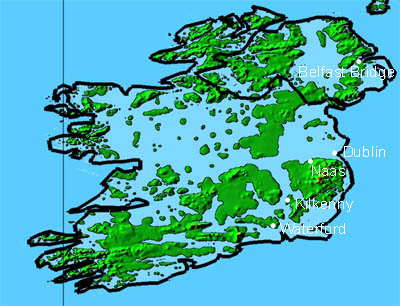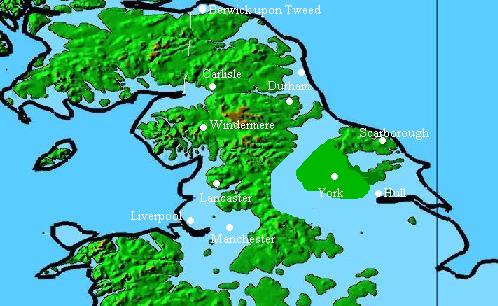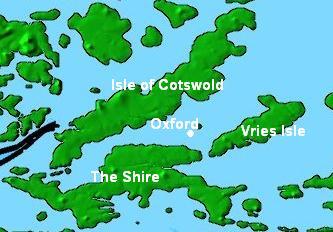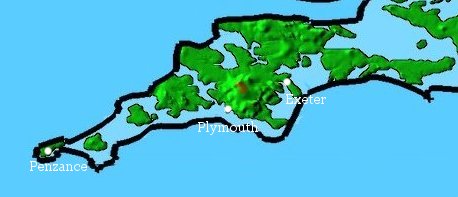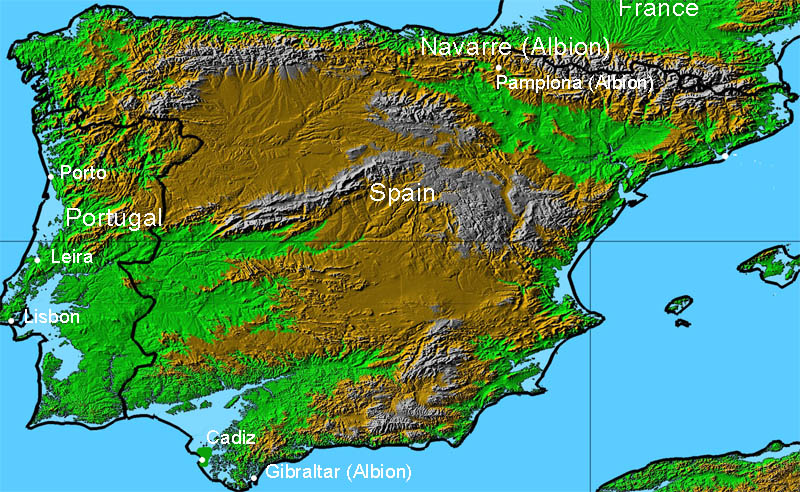The Flood
The rains began in 1607. Some say shortly before the Regicide; some after - so many records from that terrible, treacherous time have been lost that it is impossible to say when.
Although there were moments of calm in the storm, in real terms, they did not stop until 1616. The Flood was truly Biblical, and as the waters rose and rivers burst their banks, voices across the land began to cry out that the Apocalypse had come to Albion; that the Catholic scourge, or Protestant treachery, or the Jews, or the impious Puritans, or the Irish or the Magicians were to blame. Whether Magical or natural, Divine or Diabolical, the Flood sent Europe - and, to a lesser extent, countries further off - into turmoil and disaster. Cities with particularly well-regarded Magicians were the first to be protected from the floodwaters, in one method or another; residents of those unlucky cities and states without such magical protections fled, or drowned.
OC Note: Albion is not a game which tries to simulate the real world, and thus the effects of the Great Flood should not be considered in a scientific fashion. Much of the landscape has been changed by Magical effect or apparently Divine intervention; the effects upon geography are not in line with current predictions on (for example) Global Warming, but are rather metaphysically distinct to the setting. In short: This is not a hard-science game. Geography is a science.
Albion
Ireland
Ireland was changed as much as the rest of Albion during the flooding. Albion retained firm control of some of the portions, but the Pale remains in the hands of whatever Catholic magnate is able to control the lands and islands.
The most notable feature is the Belfast Bridge, which was erected to keep the two most Northeastern islands well-connected and under English control. Now known as the Belfast Isles, some of the best remaining lands there are coveted by Irish warlords.
Dublin, though an effort was made to protect it from the waters by arcane means, was evacuated and sunk beneath the waves. More recently, however, a notable magician of the Milton Academy, Master Michael Edwin, a former inhabitant of Dublin, has found a way of raising the city from under the waters. Quite how he did this is not known, but city and harbour are now above waters and reclaimed by Albion's Army as a fort and base to battle the pirates and raiders in those waters.
The castles of Naas, Kilkenny and Waterford form part of the border that Albion can effectively control and protect. Equipped with large harbours and formidable fortifications, these towns are strategically very important and their lands and waters necessarily well-protected.
Northern England
As the flood waters rose, they divided the North of England into two main parts – the Pennine Strip, which leads up into Scotland, and the Bay of Yorkshire. Most of the magicians of the North found themselves sheltered in Yorkshire by the Sisters of Hecate, and held the waters back from the monuments of York City, aided by the spirits who resided there.
After the war (during which the arrival of dragons in England was kept as quiet as possible before they could be used in battle) they came to an agreement with Lugh, the first dragon to come to Albion in search of sanctuary, to save as much of the city and lands surrounding it as possible. The price of this was a jewelled neck-piece that looks like trapped black flame, and remains unrivalled to this day.
The dragon's fire, and those of the younger beasts she corralled into helping, was applied carefully to mountains still standing above the water until they slipped to form a barrier of land around York. With many having been wiped out by the plague, particularly the poorest, the Bay came to be populated by an eclectic mix. The Horticulturalists set up a base there, whilst trying to train the gryphons who lived on Ilkley Moor, and never really left.
The bay itself became another area for expansion, with heavy defences being placed around the entrance to keep out pirates. Many of the ships anchored there could never survive in the open ocean and move, when it is required, by means of tug-boats or, for the rich, with sea-serpent or gryphon aid. Small rowing boats are in constant motion between the floating hulks, ferrying around passengers or hawking common goods.
The Pennine Strip was largely abandoned by the surviving locals in favour of Yorkshire, and so it was mostly colonised by the English moving north in search of dry land. Though not naturally fertile, witches improved the land and ensured that the integration between the English and Scots went as well as could be hoped. This was largely non-bloody and, though tensions still exist, the most militant of the Scots moved further north, across the channel of water rapidly separating the two main halves of Scotland.
Scotland
Scotland lost much less land to the Flood than the rest of Albion. Indeed, many of the Clans living deep in the Highlands didn't hear about the rising of the sea until many years later. Those who did mostly saw it as a lowland problem, clearing up the wheat from the chaff and leaving the hardy to survive.
The three main cities in Scotland all survived the flood remarkably well. Edinburgh, Glasgow and Inverness were virtually untouched, which the Scottish people attribute to their forethought and superior building techniques. However, to any half-intelligent observer it is quite obvious that the cities were magically moved inland - although any claims of Magic use is hotly contested by the Puritan Scots.
However, after the second civil war and the subsequent annexation by the Archipelago of Albion, many northern English moved up into the lowlands of Scotland to take advantage of the more sparsely-populated land. Indeed, by 1619 the number of native Scots and English in the lowlands were roughly equal. Edinburgh is still capital of Scotland, although only regional capital, and Englishmen have bought up much of the higher-class properties in the city.
Glasgow, now situated on its own island, is still mostly populated by Scots. Despite (or because of) a significant English presence the city is prone to unrest; the Dragoons have been called in numerous times to quell riots in the streets by 'loyal' Scots. Land north of Glasgow is still predominantly Scottish, with virtually no English presence north of Sterlingshire and Dundee Island. These two areas and the Isle of Fife are still predominantly Scottish but with some English presence.
The Highland Scots generally consider Inverness to now be the capital of Scotland, with Edinburgh firmly under the control of the English. However, the settlement of Iverlochy has grown extraordinarily quickly and is now an important port city. With difficult terrain and a long, thin channel to traverse from the sea, the city is very easy to defend.
South-East England
The South-East of England was hit worse than anywhere else by the flooding. All that is left is a few islands huddled together south of where London used to be. Dover still exists to an extent - it had significant land at the top of the famous Cliffs, although the docks in particular have had to be rebuilt. Brighton is a newly-expanded fishing town which has turned into a minor city due to its location.
London itself, Jewel in Albion's Crown, was sunk beneath the waves. By the end of the first Civil War, little was left worth saving and so the city was abandoned to the sea. However, this does not stop the residents of the nearby islands dreaming of better days when the capital's influence brought pride and prosperity to the area. To a large extent the residents of the islands of the South-East live in the past, telling stories of life when London was still great.
Some even hope to bring London back - there is a movement, particularly on the islands closest to London-that-was, to have London raised from the depths and rebuilt anew. They have a small lobby in parliament, although little influence in Court.
The one exception to the general mood of the South-East is the Isle of Welwyn, east of Vries Isle and very much in love with the decadence of that land. The island is rapidly becoming built up, although not so much as Vries Isle, and is home to a surprisingly large number of magicians. Society on the island generally follows trends on its neighbouring island (and by extension the capital) very closely.
South-Central England
The Island of Oxford
For how Oxford came to be the capital, see the Siege of Oxford.
The Inner Isles
Three large islands around Oxford came to great prominence as the flood waters rose and the capital was moved. Whilst the very rich moved Oxford, those that supported them and their lifestyles colonized the surrounding isles.
Isle of Cotswold
This island could be considered the machinery behind Oxford. Ugly and efficient, it supplies the servants, food and increasing number of magical items which are considered necessary for civilized life.
Walls strengthened with dragon-forged steel, towers soon shot up to house the workers required in Oxford and the other Isles. Similar improvements were made in horticulture, with racks of soil and plants stacked upon each other, and lit by Alchemical fire. This was until the Flash-Fire of 1627, which taught all inventors why mixing wooden supports and explosive lights was a bad idea, clearing large expanses of the island for further high-rise buildings, though this time with stone walls.
The Shire
It is almost as if country life before the flood had been frozen and trapped on this island. Those still too attached to their horses to trade them in for boats can ride them and, though there is very little unused land, some effort has been made to ensure that the agriculture is pleasing to the eye. If, perhaps, it is through orchards rather than forests you gallop, it is little issue.
It is here where the memorials for those who died in the Civil Wars were erected, in lieu of grave stones. A park houses them all, in a rare piece of common land that exists for no other purpose than enjoyment, and remembrance.
Vries Isle
After a strenuous day being seen in Oxford, this is where a noble might come home to relax, perhaps visiting a coffee house to talk business with a few friends, a house of entertainment where companions await to soothe away the cares of the day, or even just going home to sleep.
The rabble of financial institutes who cannot afford a presence in Oxford find their homes here, and even Roebury’s and MISC, the two who can, have their largest offices here. The Inns of Court, too, have found a new home – relocated, rumour goes, with some of the young gentlemen inside never noticing the difference.
Notable amongst the pleasure houses is Moly’s, a towering building of 21 stories which contains an inn, brothel and gaming house so that a lady, or gentleman, may engage in a variety of entertainments without ever having to brave the cold air outside. The rooms inside are lit, night and day, with a warm glow so that no unnecessary reminder of the hour might disturb the mind.
Innovations in fitting lavish houses into small spaces have increased rather rapidly in popularity – what might have been ridiculous before the flood suddenly looks sensible, and so many of the town houses here have interiors which certainly aren’t contained entirely within the walls.
It wasn’t until Lord-General de Vries’ death that this island acquired its current name, having previously been referred to (in rough order) as Watlington Isle, New London, South Oxford and the Other Place.
South-West England
Cornwall was mostly untouched by the ravages of the two Civil Wars. The flood, however, is another story. Three-quarters of the county was drowned, with much of the populace moving to the raised land in Devon. However, those that remained on the Cornish Isles have become much less happy with being controlled by England, seeing themselves as a nation in their own right and deserving of independence. The capital is considered to be Penzance, a new (and small) port city rebuilt after the original city of the same name was lost under the sea.
Exeter and Plymouth are the two largest cities in the South-West. Like Penzance, these two have been rebuilt on the new coastline, the original cities being underwater. Both are part of the single landmass that makes up most of the usable land in this part of the country. Although the island is mainly concentrated on rural life, there are also many magicians, particularly in the two cities. They make many of the items needed for everyday life, as well as luxuries for the richer. The counties from Devon eastward are mostly self-sufficient, but glad to be closer to the capital.
Wales
Wales remained very much on the Royalist side through the two civil wars. The Welsh formed a number of archery regiments which proved invaluable during the gunpowder crisis, and although Welsh fighters largely returned to Wales after the war, the Welsh remain exceptionally proud of their contribution to saving Albion from the Catholics and Scottish.
Compared to much of Albion, Wales survived the floods without losing too much land. Indeed, the island now known as the Isle of Wales contains a small but significant part of what used to be England.
As a result of its relative dryness, and the fact that it is quite close to Oxford, the Isle of Wales has seen a vast increase in population as the floods forced many Englishmen to migrate to higher land. The area surrounding Snowdon has been commandeered by the King’s Own Horticulturalists to provide space and training grounds for Albion’s dragons. The loss of their own land has rather annoyed the Welsh, but not too much, as people have paid them lots of money to move to the Isle.
Still, the primary land use in Wales is still agriculture. Livestock is no longer kept near Snowdon, as dragons have a tendency not to pay for their meals, but most of the Welsh still work in farms. Food prices have increased significantly, at least for food that isn’t fish, but the poor are still very poor. There are few major population centres — generally people are spread out fairly evenly across Wales. Shrewsbury has attracted a large number of the displaced, and Carmarthen is rapidly increasing in size as a minor port.
The Rest of Europe
Austria and the German Principalities
The various Principalities took the flood waters as a sign that independence would soon be theirs. A succession of channels were swiftly blasted in the land as they sought to mark out their preferred borders (usually stretching a fair way into neighbouring provinces, if not encompassing them entirely) with the water. Those nearer the sea swiftly scrambled for higher ground, and Austria soon found itself overwhelmed with refugees and men from the most ambitious states, armed with Alchemist's Fire.
By 1631 the extent of the devastation was apparent. What had once been the Holy Roman Empire was now a cluster of island-towns, each subsisting largely on fish, supplemented by high-yield agriculture. There was no clear leader, the Hapsburgs having been blown up in a particularly unfortunate incident involving an ambitious canal-maker, a particularly unstable batch of Alchemist's Fire and an unexpected Franzberg.
The island-towns became largely self-sufficient, as the various Princes turned to the channels looking for supremacy, and soon turned them into a battleground that was ignored by most of the populace, who saw little difference whether they were in Saxony or New Brandenburg.
France
Normandy and other Northern regions have been the most affected and France has suffered less than than some. The lands around Rennes and Caen were quickly fortified and protected by magical means and the French King ordered links to the more isolated territories to be maintained by a growing navy.
The flooding in Paris was unexpected however and half of the city quickly disappeared into the sea, many of its inhabitants drowning in the sudden cataclysm. With access to the sea however, a rebuilding effort was organised to strengthen the city against flood protection and create one of the most magnificent and beautiful harbours in Europe.
The Western lands, that had once belonged to English Kings could not be saved and Bordeaux, though not at risk of flooding, was sunk on purpose to prevent it from falling into Spanish hands whose fleet at that moment threatened the city. It is now an isle of ruin and rumours of burried and unclaimed treasures abound.
More fortunate than England, France has nevertheless suffered significantly from the floods and, like its Archipelago cousin, began to adapt to a more nautical Kingdom. To this end the King of France has begun more than any other affected country to finance and develop learning related to the seas and oceans.
Italy and the Papal States
Much of the Western coast of Italy was drowned by the Great Flood. The civil unrest following the various religious and political crises caused many hundreds of Italians to take refuge in Spain, and others to flee to the mountains, where the quiet vineyards and olive groves of the hill-farmers struggled to cope with the influx of refugees. The cities that remain were subject to even greater splits than previous; separated by the waters, few Italian city-states trust their neighbours, and frequent wars are fought over the dry territories that remain.
Venice
Any idea that Venice might be raised out of the scope of the rising waters was abandoned as soon as the philosophers of the city considered the task. Instead, the shipbuilders, gondoliers and Magicians of the town bent their minds to constructing a series of rafts and linked boats, using every scrap of timber that could be salvaged or bought; what began as a temporary attempt to save the citizenry, who might then be shipped to safer climes, rapidly grew into a permanent fixture. In a shaky alliance with the Doge, the Gondoliers' Guild shored up their floating haven, sinking pilings deep into the lagoon and using the latest advances in Alchemy and Invention to make even the most waterlogged of wood - and sometimes even stone and clay - float serenly on the surface of the waters.
In the years after the flood's end, Venice became a less beautiful state, but a more brilliant one; the Glassblowers' guild house is particularly impressive, endless, fuelless alchemical fires roaring day and night, fusing sand and melting glass but never causing so much as a scrap of wood or paper to ignite and endager the floating wooden shanty-town. To this day, the floating city of Venice, moored safely in the lee of the lagoon, is a haven for artists, madmen, dreamers, heretics and and criminals who wish to lose themselves in its endless warrens and the creaking, rope-filled darkness between boats.
Rome
It is said that the greatest Theurgists of the age may be found in Prague, but that the most enthusiastic are the Roman. Old men who were present at the event somewhat poetically referred to as the Drowning of the Tiber tell of the swarms of angels, filling the air like hummingbirds, who descended from Heaven at the behest of the Vatican's magicians, and with the divine power of Creation raised the very Hills themselves above the floodwaters. Rome now stands proud on seven islands, linked by impossibly delicate bridges criss-crossing yards above the waves, which shine with a celestial glow even in the dark. Much of the Vatican itself is still underwater, but a series of Theurgically enhanced shield-walls and subterranean defences keep the cellars and libraries of the ancient buildings dry and free from interference.
Padua
The salvation of Padua is largely attributed to a young Astrologer by the name of Galileo Galilei, whose observations of the Heavens and the resultant horoscopes led to such brilliant predictions concerning the extent of the flood, and the various methods by which Padua might be saved. There are occasional rumours that Galilei - who died in 1641, shortly after retiring as Chancellor of the justly-famed University of Padua - engaged in banned Witchcraft to enhance his predictions; and certainly, the spirits which preserved Padua through the crisis - and raised the earth around the city in a barrier so effective that even now, clean water and dry land are as common in the Paduan “bowl” as they are scarce in the rest of the Veneto - seemed more Familiar than Angelic in nature. Whatever the cause, the complicated series of locks and docking-ports that allow ships to safely descend into the Paduan Bowl, while keeping the floodwaters firmly outside, are the results of pure Inventive ingenuity; and whether it was truly his work or that of a talented apprentice, the citizens of Padua still call Galilei the “Heir of da Vinci”.
The Hill Country
The hilly regions of the Apennine and Alpine mountains are home to many farmers struggling to tame more and more land into vineyards, olive-groves and grazing-space. The scattered communities across these areas are frequently lawless, although delegations from Rome, Padua or one of the other surviving cities regularly attempt to bring them under the control of one Principal power or another. The wooded slopes of many of these mountains are a haven for petty warlords and religious fanatics, and the internal conflicts of the place make them appear more like some of the Austrian principalities than their former ordered, pastoral calm. Border-wars are frequent, bloody and often petty, and mercenaries can find good work in the employment of one or another self-proclaimed “Duke”, “Prince” or “Regent”.
The Low Countries
The Kingdom of the Netherlands in time collapsed as major cities went under water. Amsterdam, Antwerp and Utrecht were saved with great effort, using various magics, but with no lands to support them and isolated by the seas they soon turned to decline.
Dunkerque, under the direction of the Earl of Southampton was, with its surrounding countryside, established more firmly and remains an important Albion holding.
The remainder of the Kingdom of the Netherlands was eventually placed under the protectorate of Albion and then fully integrated into the Kingdom the populations spreading between the remaining land as well as France and German countries. The towns of Mons and Liege are now the only surviving prosperous Dutch towns that retain anything of the old Dutch greatness.
Malta
Malta, thanks to the professors and students of the La Valette University was raised out of the sea as the waters advanced and eventually remained effectively the same as it was. It is now one of the biggest boasts of its inhabitants.
The Hospitaller Knights of the Order of St. John, taking advantage of the increased demand of sailors, ships and sea-fighters raised a fortune in mercenary ventures for European kingdoms - but at the expense of new enemies…
Spain
Seen as a clear enemy even by those who would not condemn on the basis of religion, the Spanish became the favoured target on which to test the latest methods of war. Until its destruction in 1609 the Franswenger Cannon was turned upon them as well as the Irish, and Spain still bears the pock-marks of explosive shells. It took nearly a decade to rebuild Cadiz after the attack of a Kraken, widely believed to have been caused by a Franzberg merely intended to blow up some of the ships in the harbour. This destruction may well have caused the Spanish to fight harder, however it did ensure that once the fight in England was given up it was not just Albion that had to rebuild both cities and economy.
That Spain was touched relatively lightly by the flood convinced many English that they had caused it. Spain’s King and people boasted that though the unbelievers and heretics were punished by God for their sins, Spain has not been touched for its defense of the one true faith.
Of course its Southern and some of the Eastern coast became flooded, but Cadiz curiously remained above the waves, though it should have been consumed. Its citizens attribute this to their prayers and faith in God, but the Venerable Order simply say that it was spared so as to further enrich the Order.
Portugal
Portugal acted to protect itself against extreme flooding but made use of new towns and cities which disovered themselves with access to the sea. It is suggested that their continued success in colonisation and a strong navy are a result of this. The inland sea created in Southern Portugal, though consuming land, has shortened travelling times and stimulated trade.
The city of Porto, famous for its trade and rich lands went to extraordinary means to protect itself. Realising how the rest of Europe suffered and the waters still rising the leading nobles and merchants of Porto commisioned a project that would mark the most incredible collaboration of Church, Magics and Engineering. The particulars are still a mystery, but around its land all water breaks against some invisible shield that bars neither man nor wind or fire or earth. Many academics of Europe believe it to truly rival the Raising of the Island of Oxford itself.
Further Afield
The New World
The New World gained considerably from English and, to a lesser extent, European colonisation following the bushfire wars of the first half of the 17th Century. Rumours suggest that the Americas were to a great extent unaffected by the Great Flood, although firm reports are always difficult to come by - through a combination of difficulties in communication and the changeable, dangerous and frequently nature of the native Tribes, Empires and Nations.
Some have suggested that the lack of serious effect from the Great Flood upon the Americas confirms the theory that the natives of these great continents exist in an Edenic state, that is to say that they are spiritually pre-Fall and thus not subject to Original Sin or the dictates of Christian or Jewish theology. This is a dangerous doctrine to propose too loudly, though popular among some Spanish Catholics.
North Africa / The Ottoman empire
The lands of the Ottoman Empire remained relatively unaffected because of the flooding and only some coastal shrinkage has taken place. The biggest effect was on the Gerard Canal which widened significantly to allow faster passage and a larger volume of travel. Though complications did initially arise, the Sultan of Egypt found it prudent to offer his support to the EIC and England and prevent the Canal (as it continues to be called) from becoming uncontrolled. The problem with policing a wider channel however has meant that raiders, pirates and the occasional daring trader can sometimes slip past the Egyptian and Company patrols and toll-ships. The division has also necessitated an increase in East-West travel between the African and Asian continents for communication.
India
Many parts of India should have rightly been flooded and indeed some coastal territories did suffer, but travelers have reported a remarkable resiliance against rising sea levels. Some sailors speculate that the sea lightly dips around the Indian coast and that the mermaids serving the Murghal Emperor daily send the waters back into the ocean with their tails.
Eastern Europe
The Baltic Isles, what remains of the lands of the former Baltic Sea are now the primary trade routes into Poland and Russia. The two Kingdoms have profited from better access to the sea and the ability to compete with many new goods coming into Western Europe.
The many new waterways have had the effect of increasing communication with the East by sea meaning that the lands, and treasures no doubt hidden and protected there, are now even more open.
Scandinavia
As the flood waters rose, so did Scandinavia, though rather jerkily. Sailors claim to have heard groans, as if the land itself were in pain. Those attempting to take a closer look found themselves facing a barren wasteland, devoid of signs of human habitation, the only inhabitants animals and the dead. A few brave souls who made it further into the land talk of a wooden hall, from which the sounds of revelry issue night and day, but most dismiss that as spirit1) induced visions.
As far as anyone can tell, it is ruled by a rather imposing one-eyed man, usually seen with a holly branch and six-legged horse.
Sailors have learnt to give Denmark a wide berth as unearthly growling can be heard in its waters, and some swear their ships have nearly been overturned in a calm sea.

